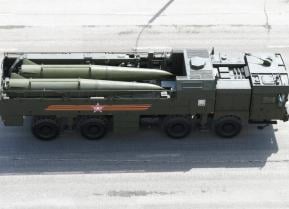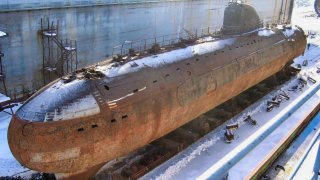Russia's First Nuclear Submarine: The November-Class Made Some Strange History
The K-3 Leninsky Komsomol, a November-Class boat built in 1957, was the Soviet Union's first-ever nuclear submarine. It was developed as part of an effort to counter the United States Navy's USS Nautilus (SSN-571), the world's first nuclear-powered sub.
Russia's Last November-class Submarine Took a Road Trip - In October 2022, a 352-foot-long "Whale" was transported through the streets of Kronstadt near Saint Petersburg, Russia. It wasn't a literal whale but was rather the sole surviving Project 627 Kit (Russian for "Whale"). Known by the NATO reporting name "November," it was the Soviet Union's first class of nuclear-powered attack submarines, which had been in service from 1958 to 1990.
The K-3, which had been at the Nerpa shipyard since 2005, was prepared for its final voyage that included being placed on a floating dock, operated by the Russian Ministry of Defense's Main Directorate for Deep-Sea Research (GUGI), where it sailed from the Barents Sea coast via the White Sea and the inner waterways to Kronstadt.
According to The Barents Observer, the floating dock, commissioned at the Zeleodolsk shipyard by the Volga River in 2015, was specially designed for sailing Russia’s inner waterways, including the White Sea Chanel that was built by Soviet prisoners in Karelia during the Stalin era.
November-Class: Meet the K-3
The K-3 Leninsky Komsomol, built in 1957, was the Soviet Union's first-ever nuclear submarine. It was developed as part of an effort to counter the United States Navy's USS Nautilus (SSN-571), the world's first nuclear-powered sub.
More than 135 Soviet organizations, including 20 design bureaus, 35 research institutes, and 80 works, participated in the design and construction of this completely new type of submarine in 1952–1958.
Interestingly, the lead vessel of the Project 627 was prototyped in wood, with each of five segments scattered between five different locations around Leningrad, including the Astoria Hotel. The K-3 submarine was subsequently built in Molotovsk, and launched in August 1957. It was commissioned the following year as part of the Soviet Navy's Northern Fleet.
The torpedo-shaped boat displaced more than 4,000 tons submerged and more than 100 meters long. Seventy-four seamen and thirty officers divided in the K-3's nine compartments, made up the boat's crew.
Despite the issues with the boats, the K-3 reached the North Pole underwater in June 1962, the first Soviet boat to achieve the feat – and just four years after the USS Nautilus.
Though the submarine suffered a fire five years later while transiting the Norwegian Sea, resulting in the death of 39 crew members, the boat was repaired and remained in service until 1988 – seeing three decades of service.
The K-3 served as the prototype submarine for a total of 12 similar subs (Project 627A) that were subsequently built, including the K-159 that sank north of Murmansk in 2003
As previously reported, the Project 627 submarines were seen excellent attack vessels. Once in range, one of these boats could strike with 533mm SET-65 or 53-65K torpedoes; yet while they were technically more powerful than their American counterparts, the Soviet subs were extremely noisy. As a result, the Project 627 vessels were easily detected and could therefore not be employed in submarine hunting operations.
Another major flaw the boats possessed was the overall lack of safety measures. Crew members were often sickened by the ship's lack of radiation shielding. Multiple incidents plagued the various November-class submarines over the years.
Preservation Efforts
After being taken out of service in 1988, the retired submarine was moved to the Nerpa shipyard in 2005, and a few years later, the work on cutting out the reactor compartment began. The nuclear reactor compartment was removed, and as a result, the restored boat is actually a bit shorter.
The boat had to be carefully moved through the streets of Kronstadt and is now scheduled to be preserved as a museum – a testament to the first Soviet nuclear-powered submarine.

There has been speculation that the Soviet-era sub was saved only because of the efforts made to preserve the USS Nautilus, which was decommissioned in 1980 and designated a National Historic Landmark in 1982. The former U.S. Navy submarine has been preserved as a museum ship at the Submarine Force Library and Museum in Groton, Connecticut, where the vessel receives around 250,000 visitors per year.
Author Experience and Expertise
Peter Suciu is a Michigan-based writer. He has contributed to more than four dozen magazines, newspapers, and websites with over 3,200 published pieces over a twenty-year career in journalism. He regularly writes about military hardware, firearms history, cybersecurity, politics, and international affairs. Peter is also a Contributing Writer for Forbes and Clearance Jobs. You can follow him on Twitter: @PeterSuciu.
Image Credit: Creative Commons.


